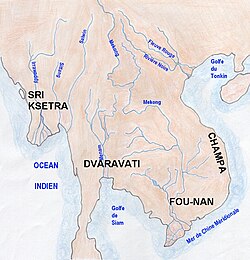
Back فونان Arabic Фунань Byelorussian হ্বূণন Bengali/Bangla Regne de Funan Catalan Funan German Reino de Funan Spanish Funanin kuningaskunta Finnish Fou-nan French Funan Hungarian Kerajaan Funan ID
Funan ហ៊្វូណន (Khmer) Hvunân | |||||||
|---|---|---|---|---|---|---|---|
| 68 CE–550 CE | |||||||
 Map of indianized kingdoms of Indochina (1st to 9th centuries CE) | |||||||
| Capital | Vyādhapūra (common), Sanskrit (religious) | ||||||
| Religion | Hinduism Buddhism | ||||||
| Government | Monarchy | ||||||
| Historical era | Classical Antiquity | ||||||
• Established | 68 CE | ||||||
• Disestablished | 550 CE | ||||||
| Currency | Native coins | ||||||
| |||||||
| Today part of | |||||||
| History of Cambodia |
|---|
| Early history |
| Post-Angkor Period |
| Colonial period |
| Independence and conflict |
| Peace process |
| Modern Cambodia |
| By topic |
|
|
Funan (Chinese: 扶南; pinyin: Fúnán; Khmer: ហ៊្វូណន, Hvunân [fuːnɑːn]; Vietnamese: Phù Nam, Chữ Hán: 夫南) was the name given by Chinese cartographers, geographers and writers to an ancient Indianized state—or, rather a loose network of states (Mandala)[1][2]—located in mainland Southeast Asia centered on the Mekong Delta that existed from the first to sixth century CE. The name is found in Chinese historical texts describing the kingdom, and the most extensive descriptions are largely based on the report of two Chinese diplomats, Kang Tai and Zhu Ying, representing the Eastern Wu dynasty who sojourned in Funan in the mid-3rd century CE.[3]: 24
Funan is known in the modern languages of the region as Vnum (Old Khmer: វ្នំ), Nokor Phnom (Khmer: នគរភ្នំ, Nôkôr Phnum [nɔkɔː pʰnum], lit. 'Mountain Kingdom'), Fūnān (Thai: ฟูนาน), and Phù Nam (Vietnamese). However, the name Funan is not found in any texts of local origin from the period, and it is not known what name the people of Funan gave to their polity. Some scholars argued that ancient Chinese scholars transcribed the word Funan from a word related to vnaṃ (modern: phnoṃ, meaning "mountain"). Others, however, thought that Funan may not be a transcription at all, but rather it meant what it says in Chinese. The first inscription in the Khmer language is dated shortly after the fall of Funan.
Like the very name of the kingdom, the ethno-linguistic nature of the people is the subject of much discussion among specialists. The leading hypotheses are that the Funanese were mostly Mon–Khmer, or that they were mostly Austronesian, or that they constituted a multi-ethnic society. The available evidence is inconclusive on this issue. Michael Vickery has said that, even though identification of the language of Funan is not possible, the evidence strongly suggests that the population was Khmer.[4] However, several studies demonstrates that inhabitants of Funan probably spoke Malayo-Polynesian languages, as in neighboring Champa.[5][6] The results of archaeology at Oc Eo have demonstrated "no true discontinuity between Oc Eo and pre-Angkorian levels", indicating Khmer linguistic dominance in the area under Funan control.[7]
Based on the testimony of the Chinese historians, the polity Funan is believed to have been established in the 1st century CE in the Mekong Delta, but archaeological research has shown that extensive human settlement in the region may have gone back as far as the 4th century BCE. Though regarded by Chinese authors as a single unified polity, some modern scholars suspect that Funan may have been a collection of city-states that sometimes were at war with one another and at other times constituted a political unity.[8] From archaeological evidence, which includes Roman, Chinese, and Indian goods excavated at the ancient mercantile centre of Óc Eo in southern Vietnam, it is known that Funan must have been a powerful trading state.[9] Excavations at Angkor Borei in southern Cambodia have likewise delivered evidence of an important settlement. Since Óc Eo was linked to a port on the coast and to Angkor Borei by a system of canals, it is possible that all of these locations together constituted the heartland of Funan.
- ^ Martin Stuart-Fox (2003). A Short History of China and Southeast Asia: Tribute, Trade and Influence. Allen & Unwin. p. 29. ISBN 9781864489545.
- ^ Dougald JW O′Reilly (2007). Early Civilizations of Southeast Asia. Altamira Press. p. 194.
- ^ Higham, C., 2001, The Civilization of Angkor, London: Weidenfeld & Nicolson, ISBN 9781842125847
- ^ Michael Vickery, "Funan reviewed: Deconstructing the Ancients", Bulletin de l'École Française d'Extrême Orient XC-XCI (2003–2004), pp. 101–143
- ^ Trude Jacobsen (2016). "Funan, Kingdom of". The Encyclopedia of Empire. pp. 1–2. doi:10.1002/9781118455074.wbeoe059. ISBN 978-1-118-44064-3.
- ^ Minh Giang Vu (2022). "FUNAN (Phu Nam) from a new perspective". Journal of Social Science and Humanities. 64 (3): 71–85. doi:10.31276/VMOSTJOSSH.64(3).71-85.
- ^ Pierre-Yves Manguin, "From Funan to Sriwijaya: Cultural continuities and discontinuities in the Early Historical maritime states of Southeast Asia", in 25 tahun kerjasama Pusat Penelitian Arkeologi dan Ecole française d'Extrême-Orient, Jakarta, Pusat Penelitian Arkeologi / EFEO, 2002, p. 59-82.
- ^ Hà Văn Tấn, "Oc Eo: Endogenous and Exogenous Elements", Viet Nam Social Sciences, 1–2 (7–8), 1986, pp.91–101.
- ^ Lương Ninh, "Funan Kingdom: A Historical Turning Point", Vietnam Archaeology, 147 3/2007: 74–89.
© MMXXIII Rich X Search. We shall prevail. All rights reserved. Rich X Search